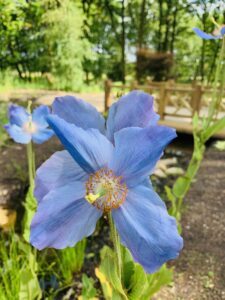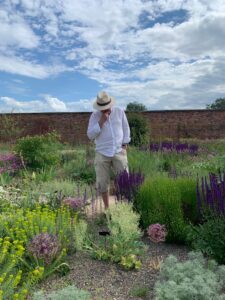Written 23rd June 2021 by David Abbott
Last week a group of Olliers colleagues visited the new RHS Bridgewater gardens, as part of the firm’s wellness programme, which encourages staff to look after their own mental and physical wellbeing by participating in non-legal activities in office time.
 The gardens are situated just off the M60 at Worsley; they are the fifth gardens to be built by the Royal Horticultural Society , and the first in the North West of England. They have been created on the site of what was Worsley New Hall , a huge Gothic Victorian mansion and its extensive grounds, which consisted of raised terraces, walled gardens, woodland, and meadows running down to the adjacent Bridgewater canal. The ongoing garden development is currently the largest horticultural project in Europe.
The gardens are situated just off the M60 at Worsley; they are the fifth gardens to be built by the Royal Horticultural Society , and the first in the North West of England. They have been created on the site of what was Worsley New Hall , a huge Gothic Victorian mansion and its extensive grounds, which consisted of raised terraces, walled gardens, woodland, and meadows running down to the adjacent Bridgewater canal. The ongoing garden development is currently the largest horticultural project in Europe.
Worsley New Hall is long gone, having been finally demolished just after the last war following years of slow decay. No trace of it remains, save for the raised terraces upon which it stood , plus below them, a large and tranquil lake, which brims with wildlife; when we visited the highlights were coots and their fluffy offspring, flowering waterlilies, and shimmering-blue damselflies skimming the water in courtship.
In addition to the lake , the brick- built walled gardens, which in Victorian times would have grown flowers and vegetable produce for the “big house” do remain, and they are the centrepieces of the new RHS gardens.
 Walled gardens create their own microclimate, by providing shelter from damaging winds, and by their walls radiating heat. This has enabled the RHS to grow plants which wouldn’t otherwise survive in the North of England.
Walled gardens create their own microclimate, by providing shelter from damaging winds, and by their walls radiating heat. This has enabled the RHS to grow plants which wouldn’t otherwise survive in the North of England.
In the most protected part of the walled garden is the “Paradise garden”, based on the ancient “paradises” of the near East. This has been planted with Mediterranean and Asian plants, many of them aromatic , and which need little in the way of watering. There are 89 individual planting beds containing 27,000 plants and the result is a calm, tranquil, colourful oasis.
Modern garden design is all about planning for climate change; when planning a garden to last for a century , as the RHS must be here, one has to factor-in the likelihood of much drier summers and to choose plants that will cope with those conditions: so plants that originate in the dry, stony soils of the Near East are a perfect choice for a new garden for a new century.
Along two south-facing walls have been built new long, lean-to greenhouses within which there are going to grow grapevines , figs, peach trees and the like; environmentally- friendly biomass-fired heating in winter replacing the coal-fired hot water systems which heated the greenhouses here in the Victorian era.
Outside of the formal walled garden there are long drifts of wild meadow-flowers – ox-eye daisies , cornflowers and corncockles, which attract insects in abundance.
 The use of water features strongly throughout the gardens; the uppermost original lake feeds a stream which runs through woodland and which becomes a Chinese streamside garden, recently planted with Asiatic trees on its banks. There are formal ponds and rills of trickling water in the walled gardens also.
The use of water features strongly throughout the gardens; the uppermost original lake feeds a stream which runs through woodland and which becomes a Chinese streamside garden, recently planted with Asiatic trees on its banks. There are formal ponds and rills of trickling water in the walled gardens also.
There is extensive woodland to stroll through on well-made paths. The long stream feeds into a newly-created lake , adjacent to which sits the “Welcome building”, which houses all of the usual facilities – etc all tastefully done in typical RHS style.
The development of the gardens is an ongoing process; it will be interesting to visit again in a year or two to see how the gardens are developing and maturing but it is already a place to be recommended. The Olliers group left feeling suitably relaxed.
- About the Author
- Latest Posts
David joined Olliers Solicitors in 1982, qualifying in 1984 and spent many years as a partner of Olliers working within our Magistrates’ Court and Crown Court departments. He recently taken up the post of Head of Corporate Social Responsibility.

